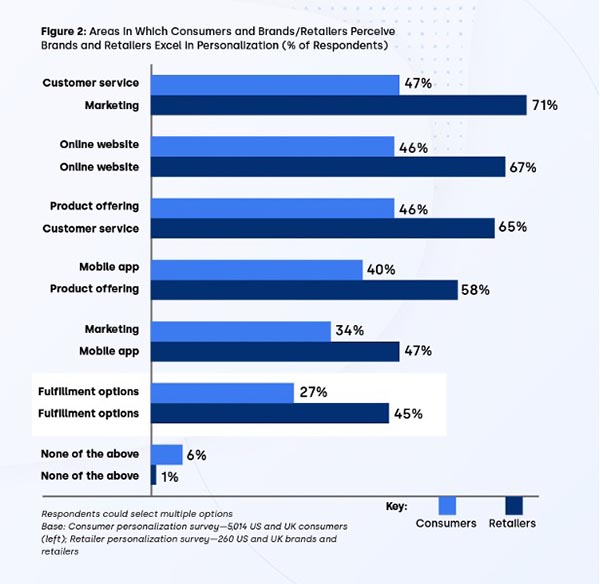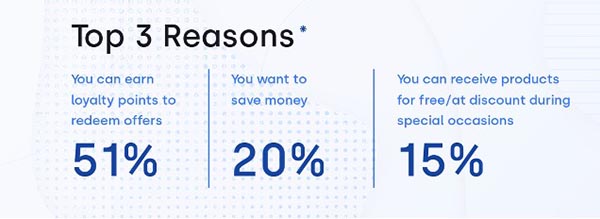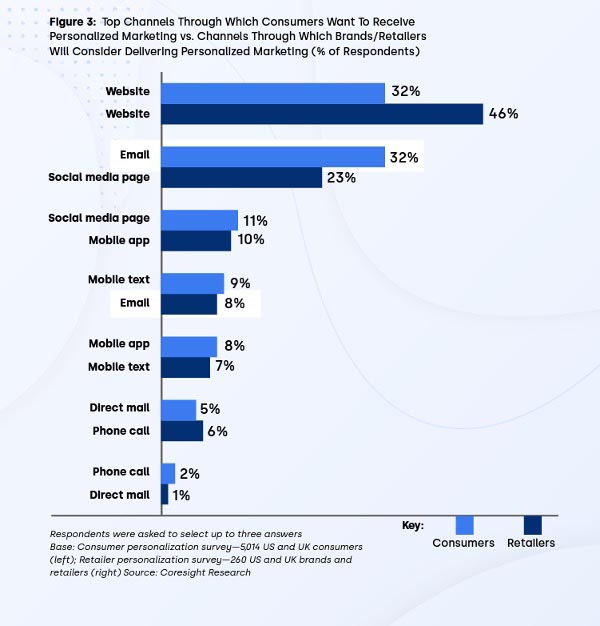According to new data from Sailthru, 71% of retailers think they are doing great when it comes to personalization, yet only 34% of consumers feel the same. Could some of this be because retailers are focusing on the wrong things? This is the suggestion made by the study, “Retail Personalization in 2022: Balancing Trust, Data Collection, and Privacy.”
The study looks at the difference in perceptions between consumers and retailers on a variety of issues related to retail personalization and data privacy, as well as areas such as loyalty programs and channel usage. The results are based on three Coresight Research surveys: two sent to consumers and sent one to brands and retailers in the US and the UK. Nearly all of the retailers surveyed (98%) use personalization tactics of some sort, so these responses are coming from retailers already actively using these technologies.
There are lots of takeaways from the study, but here are the ones that caught my eye. How do they line up with how you are shaping your customer relationships?
- The disconnect between what retailers think and what consumers think. This gap between 71% and 34% is significant. How can a gap be this large and retailers are unaware of it? Maybe it suggests that retailers (and brands of all kinds) should take the axiom to heart: “Less talking. More listening.” In other words, we use marketing communications to build brands, sell products, and deepen customer engagement. But how often are those communications used to listen?

Source: Sailthru “Retail Personalization in 2022”
- “Personalization” includes cross-channel experiences. Sailthru noted three ways that retailers can deliver personalization to their customers. One of the three (in addition to product recommendations and personalized browsing, pricing, and promotional strategies) is “delivering a consistent shopping experience across desktop, in-store, and mobile sites, as well as email.” We don’t immediately associate cross-channel consistency with personalization, but it makes perfect sense. If my email, mobile, and online shopping experiences are completely different, even if those experiences are “personalized,” that lack of continuity undermines that attempt to make me feel special.
- The deeper the relationship between the consumer and the brand, the more they are willing to share their personal data. Sailthru found that while 96% of consumers have concerns about data sharing and privacy, this melts away when customers are clearly shown the benefits. More than one-third (36%) of consumers feel "positive" about sharing personal data in exchange for personalized recommendations and experiences. How much time are brands spending communicating to shoppers the value of providing their personal data? Or are they just assuming buyers know?
What data are consumers most willing to share? Top-level data (name, email address, gender) is far easier to obtain than more detailed, sensitive data such as home address and phone number. But the deeper the relationship with the brand, the more data consumers are willing to share. Sailthru found a 7%–10% differential between willingness to share data with a known, trusted brand with whom they have a relationship over a brand they had not yet done business with.
- Loyalty programs remain a great way to engage with customers and bring value, but the value doesn’t always have to be about discounts. In fact, the study found that shoppers are more interested in joining loyalty programs as a way to earn loyalty points and “redeem offers” (51%) than they are using them to save money (20%). In other words, offers don’t have to be about getting discounts or free stuff. They can also be things like access to events, free or discounted shipping, and access to new releases before everyone else. Insider offers, VIP deals, and members-only events are more popular than discounts among younger audiences.

Source: Sailthru “Retail Personalization in 2022”
- Being transparent about how you collect and use data is important to building trust. Consumers are more likely to share data if they trust that you are going to use it in ways that they understand and feel comfortable with. Ensure that you are being transparent about data collection practices and how that data will be used.
- Consumers value email personalization more than retailers do. Nearly one-third of consumers cited email as the most important channel for receiving personalized content, a tie with websites for the top spot. But less than 10% of brands and retailers reported email as important as consumers did. If you have to be pick on email or websites to focus on, email might be your better choice. Retailers also focused more on social media than consumers do.

Source: Sailthru “Retail Personalization in 2022”
- Pay attention to fulfillment. With the COVID-19 pandemic having driven heightened fulfillment expectations among consumers, Sailthru finds, brands and retailers can gain a competitive edge by using inventory/delivery notifications as another way to connect to customers, deliver value, and build trust.
- Consumers don’t really care about personalized direct mail. Despite all of the talk in our industry about personalizing direct mail, only 5% of shoppers in the Sailthru survey saw direct mail as a channel through which they want to visibly, noticeably see personalized content. That doesn’t mean that personalized content isn’t important—using data to create relevance to the recipient behind the scenes can determine whether the recipient pitches or reads it—but the noticeable, visible personalization that we used to talk about so much in the early days of personalized printing isn’t really on the radar.
So there you have it—Sailthru’s “State of Personalization 2022.” What do you think? Do you buy it? Got a different opinion? Your experience tell a different story? Leave a comment.










Discussion
Join the discussion Sign In or Become a Member, doing so is simple and free